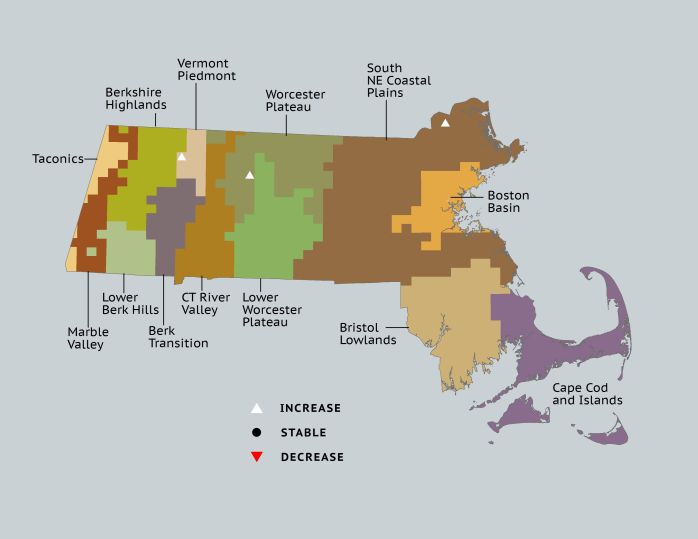Breeding Bird Atlases (BBA)
Find a Bird
White-winged Crossbill
Loxia leucoptera

Very local, trend not established
“Plenty sits still. Hunger is a wanderer.” – Zulu proverb
The forest sometimes seems to speak as a chorus of dry mellow chit notes emanate from a thick stand of spruces on a lonely mountainside. Seconds later, a cloud of pink birds with black-and-white wings rises as one to forage elsewhere, their hunger urging them on to the next leg of the eternal journey that defines the existence of the White-winged Crossbill. Like the Red Crossbill, this species is an infamous wanderer throughout northern North America. Not until very recently, however, did their wanderings bring them to our Commonwealth to breed.
Historic Status
The White-winged Crossbill was as unpredictable in the old days as it is today, some years arriving in large numbers to spend the winter in Massachusetts, and in other winters hardly arriving at all. Nineteenth-century ornithologists kept track of particularly heavy crossbill flights and usually logged them for posterity, but beyond this they generally had little to say about them (Howe & Allen 1901). Apparently no nests were ever discovered, although one has to wonder if from time to time a lingerer or two may have sheltered deep in some spruce or hemlock forest to nest in anonymity.
Atlas 1 Distribution
Despite its history of notable and highly erratic winter appearances in Massachusetts, the White-winged Crossbill was never known to breed in the state prior to Atlas 1. Though this species can breed at any time of the year and is known to be highly nomadic, the only evidence of apparent breeding in the state was the occasional appearance of young seen in western Massachusetts during the summer. Atlas 1 also came and went without anyone uncovering any substantive proof of White-winged Crossbills breeding in the Bay State.
Atlas 2 Distribution and Change
During the inter-Atlas period, however, White-winged Crossbills staged a major irruption in 2000, and many remained in the state through the following winter. Courtship behavior was observed during this period, and in late February of 2001 an adult White-winged Crossbill was ultimately seen feeding several barely fledged young. This event marked the first-ever Confirmation of breeding White-winged Crossbills in Massachusetts. During Atlas 2, White-winged Crossbills continued to be difficult to forecast, but they nonetheless showed modest “gains” in the state, including two more Confirmations. While more likely attributable to the irruptive behavior of White-winged Crossbills rather than to an increase in their population, these records are interesting nonetheless.
Atlas 1 Map

Atlas 2 Map

Atlas Change Map

Ecoregion Data
Atlas 1 | Atlas 2 | Change | ||||||
Ecoregion | # Blocks | % Blocks | % of Range | # Blocks | % Blocks | % of Range | Change in # Blocks | Change in % Blocks |
Taconic Mountains | 0 | 0.0 | 0.0 | 0 | 0.0 | 0.0 | 0 | 0.0 |
Marble Valleys/Housatonic Valley | 0 | 0.0 | 0.0 | 0 | 0.0 | 0.0 | 0 | 0.0 |
Berkshire Highlands | 0 | 0.0 | 0.0 | 0 | 0.0 | 0.0 | 0 | 0.0 |
Lower Berkshire Hills | 0 | 0.0 | 0.0 | 0 | 0.0 | 0.0 | 0 | 0.0 |
Vermont Piedmont | 0 | 0.0 | 0.0 | 1 | 5.9 | 25.0 | 1 | 8.3 |
Berkshire Transition | 0 | 0.0 | 0.0 | 0 | 0.0 | 0.0 | 0 | 0.0 |
Connecticut River Valley | 0 | 0.0 | 0.0 | 0 | 0.0 | 0.0 | 0 | 0.0 |
Worcester Plateau | 0 | 0.0 | 0.0 | 1 | 1.1 | 25.0 | 1 | 2.1 |
Lower Worcester Plateau | 0 | 0.0 | 0.0 | 1 | 1.3 | 25.0 | 0 | 0.0 |
S. New England Coastal Plains and Hills | 0 | 0.0 | 0.0 | 1 | 0.4 | 25.0 | 1 | 0.4 |
Boston Basin | 0 | 0.0 | 0.0 | 0 | 0.0 | 0.0 | 0 | 0.0 |
Bristol and Narragansett Lowlands | 0 | 0.0 | 0.0 | 0 | 0.0 | 0.0 | 0 | 0.0 |
Cape Cod and Islands | 0 | 0.0 | 0.0 | 0 | 0.0 | 0.0 | 0 | 0.0 |
Statewide Total | 0 | 0.0 | 0.0 | 4 | 0.4 | 100.0 | 3 | 0.4 |



